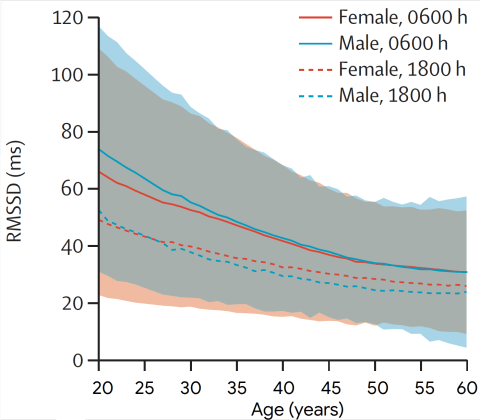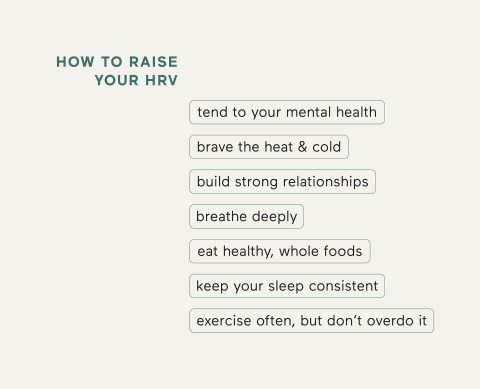Advertisement
How To Calculate Your Ideal HRV & 8 Ways To Get Closer To It


What if there was a way to know how prepared your body was to do a tough workout, solve a complex problem, or get through a long workday? Turns out, there is: your heart rate variability (HRV) is a real-time health report that's constantly at your disposal.
While it's tempting to compare your HRV to someone else's, the metric is highly personal and influenced by factors like genetics, age, and even pregnancy or menstruation status. Just because you have a "low" HRV compared to your friend doesn't necessarily mean you are in bad shape or overly stressed.
In this article, we'll share average heart rate variability charts, describe why this metric is so variable, and provide tips on how to reach the best score for you.
The need-to-knows:
- The higher, the better: Having a higher HRV means that the branches of your nervous system are working in concert and not overpowering each other. This is a sign you are fit, well rested, and recovering for long enough.
- HRV is personal: Unlike metrics like resting heart rate, there is no ideal range for HRV since it's so variable from person to person. Even some pro athletes don't have particularly "high" HRVs, thanks to their genetics.
- Don't let it stress you out: Your HRV is always changing—but that doesn't mean you need to check it at every hour of the day. Look at your score once (preferably first thing in the morning) and take note of trends over time. Making simple changes, like breathing more deeply or walking more, will help bring your HRV up.
What is HRV?
Your heart doesn't beat at a uniform clip; different amounts of time pass between consecutive heartbeats. Heart rate variability is a measurement of this time variation between heartbeats in milliseconds.
To understand why this nitty-gritty health metric is important, you need to know about the autonomic nervous system (ANS). If your HRV is an orchestra, your ANS is its conductor.
The ANS comprises your parasympathetic (rest-and-digest) and sympathetic (fight-or-flight) networks. These networks constantly send signals that dictate how your body uses resources. When you are fighting off a cold, for example, the sympathetic nervous system overrides the parasympathetic; it sends a loud and clear signal that now is not the time to relax.
The more attuned your HRV is to these signals, the higher it will be. If you have a high HRV, that means that the signals from the parasympathetic and sympathetic systems are well balanced, and your body is responding to them quickly. If your HRV is lower, that's a sign that one system is overriding the other (almost always the sympathetic1) and calling the shots.
"HRV can be an indicator that our bodies are under stress or responding to illness," says Aravind Natarajan, Ph.D., a physicist and staff research scientist at Fitbit.
Your HRV is bound to dip when you get sick, have a poor night of sleep, or finish a tough workout. But over time, you want your general HRV trends to be high. Having a consistently low HRV indicates that your body is under chronic stress, and it could put you at risk for heart attack and stroke2.
When used properly, HRV can be a valuable biofeedback metric that provides clues on how to deepen sleep, optimize athletic performance, improve mental health, and more.
Some people naturally have a higher HRV than others. However, there are plenty of ways that you can improve upon your baseline through lifestyle change.
Summary
Heart rate variability chart
The scientific community's interest in HRV has skyrocketed over the past few decades, and research studies on it have increased by 500% since 2000. An important finding from this research has been that some factors that influence HRV are out of our control, like genetics, age, and sex.
This is demonstrated by the following heart rate variability chart, from a 2020 study on Fitbit data from 8 million users3' smartwatch data. (Note: RMSSD is equivalent to HRV.)

As you can see, HRV measurements decrease most rapidly between the ages of 20 and 40 and then even out. (Separate research has found that those who reach 100 years old tend to experience another rapid dip in HRV4, due mostly to a quick decrease in parasympathetic activity.) This chart also shows that men tend to have a higher HRV than females until the age of 50, after which there are no sex differences. Genetics also play a significant role in your HRV score, as shown by research on twins5. Conditions like cardiac arrhythmia can also affect HRV readings, as can hormonal changes due to menstruation6, pregnancy7, and menopause8.
For these reasons, there is no such thing as a universally "good" or "bad" HRV—it's personal. You could follow an identical health routine as someone else but still have wildly different readings.
"HRV is highly individualized, fluctuating daily and from person to person. What is considered a healthy heart rate variability differs for everyone," Poonam Desai, M.D., an integrative physician focusing on longevity medicine, tells mindbodygreen.
Here are the average HRV measurements9 for a few different age ranges from the Fitbit study (all readings taken between 6 a.m. and 7 a.m.). But again, remember that it's highly personal, and the important thing is working to reach the best HRV for your body.
Men:
- 25-26 years old: 61 ms
- 30-31 years old: 56 ms
- 35-36 years old: 49 ms
- 40-41 years old: 43 ms
- 45-46 years old: 37 ms
- 50-51 years old: 34 ms
- 55-56 years old: 32 ms
- 60-61 years old: 31 ms
Women:
- 25-26 years old: 57
- 30-31 years old: 53
- 35-36 years old: 47
- 40-41 years old: 42
- 45-46 years old: 37
- 50-51 years old: 34
- 55-56 years old: 33
- 60-61 years old: 31
How to measure and monitor HRV
As the lines on the heart rate variability chart show, HRV tends to be higher in the morning than at night. This is because right when you wake up, your body will (hopefully) be fully recovered. As the day goes on, workouts and stressors will tax your nervous system and bring your score down.
This is why most experts recommend taking an HRV reading first thing in the morning (within five minutes of waking) to get a sense of your baseline.
Get in the habit of taking your reading at the same time every day to get a sense of trends over time. Changes in your weekly score can tell you how you're doing in the recovery department that week, while monthly changes give you an idea of how your overall fitness is trending.
The easiest way to take a reading at home is to use an HRV monitor like Fitbit, WHOOP, or Oura ring. These wearables estimate your HRV using pulse readings. While they aren't as accurate as an electrocardiogram (ECG) reading, they make it easy to track your HRV over time and monitor its changes from home.
It's best to wear them during sleep for a more accurate reading, but putting them on first thing in the morning works too.
"You'll want to pay special attention to the days that your HRV is out of your personal range," says Natarajan. Let's say your HRV is usually in the 70-80 range but then dips to the 50s one morning. This could be a sign that your body is under mental or physical strain and it's time to prioritize recovery using the ideas below.
Summary
How to improve your HRV
If your HRV is lower than you'd like, there are plenty of ways to help your ANS recover and regain balance. But since your HRV is partially genetically influenced, you can only raise it so much.
Longevity medicine specialist Peter Attia, M.D., estimates on his podcast, The Drive, that it's reasonable to expect to raise your baseline by about 50%. So, if your average HRV is around 20, lifestyle changes could help you get it up to 30.
As for how long it typically takes to raise HRV scores, Natarajan notes that it depends what's causing your HRV to dip in the first place. "If you are sick, it can be as easy as waiting to recover. If your HRV was low because you had a late night of drinking, then the next night can be an opportunity to recover your HRV," he says. If your body isn't under an additional stressor, it could take a few weeks to work your way to a consistently increased score.
Here are a few accessible and affordable methods you can use to noticeably increase your HRV. This list just scratches the surface on bringing up your score—check out our full guide to improving your HRV here.
- Tend to mental health: Our mental health directly affects our physical health, and stressful experiences and trauma can absolutely lower HRV10. Gratitude practices, reflective journaling11, and talk therapy can all help raise your HRV long term.
- Brave the heat and/or cold: Not all stress is bad for your HRV. Saunas and ice baths are examples of "hormetic stressors" that provoke short-term stress and ultimately make the body more resilient. Both hot12 and cold therapy13 have been shown to reduce cardiovascular health risks and promote nervous system balance14. Here's a guide to getting started with ice bathing or sauna soaking (or both!).
- Build strong relationships: Socializing with friends and loved ones can help us feel safe and at ease. And indeed, researchers have found that those who have higher HRVs tend to report having healthier, stronger relationships on average15, while loneliness is a risk factor for a lower HRV16. All the more reason to invest in your friendships every day.
- Breathe deeply: Tuning in to your breath can help you relieve stress very quickly. If you feel yourself getting worked up, taking slow, deep breaths can serve as a "manual override" for the autonomic nervous system, Emily Capodilupo, Ph.D., a researcher and data scientist at WHOOP says on the WHOOP podcast. Making your exhales longer than your inhales can help activate the parasympathetic nervous system and lower heart rate, Capodilupo explains.
- Eat a healthy whole-foods diet: There doesn't seem to be an ideal eating plan for improving HRV, but prioritizing whole foods and limiting processed, fatty, sugary items is a good place to start. There is also some literature to show that leafy greens, omega-3 fatty acids, B vitamins, probiotics, and polyphenols can benefit HRV acutely and in the longer term17. Like keeping your sleep schedule consistent, eating your meals at similar times every day can help minimize stress on the body. Avoid eating too close to bed (within two to three hours) to preserve your deep sleep.
- Keep your sleep consistent: Sleep is when your body recovers, so it's no surprise that a good night's rest can support a healthy HRV18 quite a bit. Maintaining a regular sleep schedule (going to bed and waking up at the same time every day) is one of the best ways to promote deep, consistent sleep.
- Exercise often—but don't overdo it: In general (but not always), the more physically fit you are, the higher your HRV. While your HRV will decrease after a workout due to the strain on your body, it should bounce back up (hopefully to an even higher level) once you recover. This is why giving your body a break after a tough workout is so essential. "Exercise does make a difference, but intelligent exercise makes more of a difference. Intelligent exercise is not overdoing a workout for too many days without giving your body an opportunity to recover," says Desai. Natarajan also notes that you don't have to run marathons or do HIIT workouts to raise your HRV, either. Doing a few more minutes of zone two cardio training or walking 200 more steps a day is enough to increase your readings over time.
- Drink plenty of water: Staying hydrated (and supplementing with electrolytes as needed) can also bump up your score and decrease your resting heart rate19. Will Ahmed, the founder and CEO of WHOOP, even said hydration was one of the most underrated influences on heart rate variability when he stopped by the mindbodygreen podcast.
Science spotlight:
The mindbodygreen POV
Heart rate variability is a valuable metric for those looking to optimize their recovery and perform at their best. Read: Pretty much all of us! We suggest checking your score each morning to get an idea of how you can show up for the day ahead in a way that works for your body. Since HRV is highly variable, it's best to keep track of how your own score changes over time rather than comparing it to other people's (and we kind of love this personal element of it).
Declines in HRV can be a signal that you're getting sick or need to take it easy. Sleep is the cornerstone of good health, and they can alert you that you need to pay more attention to yours, too.
This doesn't apply to you if:
That said, if checking your score is a source of anxiety or every dip causes you to worry, we suggest taking a break from HRV tracking or forgetting about it altogether. After all, if you're stressed about your HRV, it will just continue to bring your score in the wrong direction!
Those with heart arrhythmias or atrial fibrillation may find that their HRV data is disrupted or not entirely accurate. If you have a heart condition, work with your cardiologist to see if HRV tracking is right for you.
FAQ
What is a good HRV for my age?
Heart rate variability is personal, and a "good" or "bad" score is relative. That said, a study that collected Fitbit data on 8 million people found that the average HRV for men in their 20s is roughly 61 (ms); in their 30s is 49; in their 40s is 37; in their 50s is 32; and in their 60s is 31. The average HRV for women in their 20s is roughly 57; in their 30s is 47; in their 40s is 37; in their 50s is 33; and in their 60s is 31.
Should I worry if my HRV is low?
Having a consistently low HRV could put you at risk for cardiovascular issues. However, constantly stressing about your HRV will likely only rev up your sympathetic nervous system more. Focus on the factors that are within your control (sleep, exercise, eat healthy, stay hydrated, etc.) and let go of the rest.
The takeaway
Heart rate variability is a valuable metric of nervous system health that we can all use to optimize our recovery. It's difficult to chart a "good" HRV range since it's different for everyone and changes with factors like age and pregnancy status. A steady increase in your personal score indicates that your body has nailed the balance of exertion and recovery. Ready to take your readings more seriously? Check out the most accurate and detailed HRV monitors of the year.
19 Sources
- https://www.ncbi.nlm.nih.gov/pmc/articles/PMC5900369/
- https://www.ncbi.nlm.nih.gov/pmc/articles/PMC5821272
- https://www.thelancet.com/journals/landig/article/PIIS2589-7500%2820%2930246-6/fulltext
- https://www.frontiersin.org/articles/10.3389/fphys.2020.566399/full
- https://www.ncbi.nlm.nih.gov/pmc/articles/PMC5075267/
- https://www.ncbi.nlm.nih.gov/pmc/articles/PMC4625231/
- https://www.ncbi.nlm.nih.gov/pmc/articles/PMC7113937/
- https://pubmed.ncbi.nlm.nih.gov/35608101/
- https://www.thelancet.com/cms/10.1016/S2589-7500(20)30246-6/attachment/5fe9e9b1-08cc-452c-bb94-4a2f7da8316c/mmc1.pdf
- https://www.ncbi.nlm.nih.gov/pmc/articles/PMC4862083/
- https://pubmed.ncbi.nlm.nih.gov/27187845/
- https://pubmed.ncbi.nlm.nih.gov/30077204/
- https://www.ncbi.nlm.nih.gov/pmc/articles/PMC6204981/
- https://pubmed.ncbi.nlm.nih.gov/21941017/
- https://pubmed.ncbi.nlm.nih.gov/35569090/
- https://pubmed.ncbi.nlm.nih.gov/34574777/
- https://www.ncbi.nlm.nih.gov/pmc/articles/PMC5882295/
- https://pubmed.ncbi.nlm.nih.gov/35565165/
- https://pubmed.ncbi.nlm.nih.gov/32078090/
Watch Next
Enjoy some of our favorite clips from classes
Enjoy some of our favorite clips from classes
What Is Meditation?
Mindfulness/Spirituality | Light Watkins
Box Breathing
Mindfulness/Spirituality | Gwen Dittmar
What Breathwork Can Address
Mindfulness/Spirituality | Gwen Dittmar
The 8 Limbs of Yoga - What is Asana?
Yoga | Caley Alyssa
Two Standing Postures to Open Up Tight Hips
Yoga | Caley Alyssa
How Plants Can Optimize Athletic Performance
Nutrition | Rich Roll
What to Eat Before a Workout
Nutrition | Rich Roll
How Ayurveda Helps Us Navigate Modern Life
Nutrition | Sahara Rose
Messages About Love & Relationships
Love & Relationships | Esther Perel
Love Languages
Love & Relationships | Esther Perel
What Is Meditation?
Box Breathing
What Breathwork Can Address
The 8 Limbs of Yoga - What is Asana?
Two Standing Postures to Open Up Tight Hips
How Plants Can Optimize Athletic Performance
What to Eat Before a Workout
How Ayurveda Helps Us Navigate Modern Life
Messages About Love & Relationships
Love Languages
Advertisement

Your Grandma's Go-To Supplement Is Once Again Popular (For A Good Reason)
Molly Knudsen, M.S., RDN

This Type Of Fat Is Vital For Women's Health — Are You Getting Enough?
Molly Knudsen, M.S., RDN

New Study Confirms The 3 Habits That Age Your Brain Faster
Molly Knudsen, M.S., RDN

Your Grandma's Go-To Supplement Is Once Again Popular (For A Good Reason)
Molly Knudsen, M.S., RDN

This Type Of Fat Is Vital For Women's Health — Are You Getting Enough?
Molly Knudsen, M.S., RDN

New Study Confirms The 3 Habits That Age Your Brain Faster
Molly Knudsen, M.S., RDN












